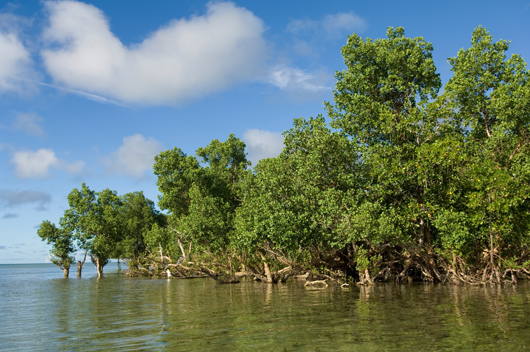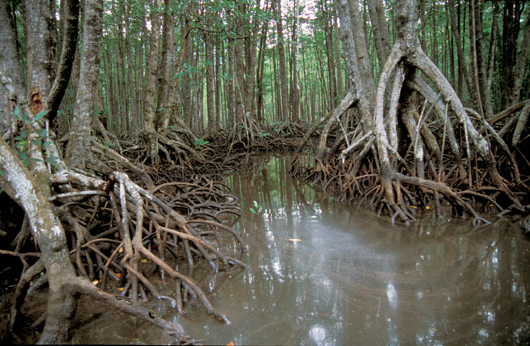New study investigates the scale of global mangrove losses
20.04.10
A new report in the open access journal Plos One raises the very real threat of extinction to mangroves; tree species supremely adapted to tropical and sub-tropical coasts.
The report, carried out by the Global Marine Species Assessment (GMSA) - part of the Biodiversity Assessment Unit, a joint initiative of IUCN and Conservation International - aimed to fill the existing knowledge gaps surrounding mangroves, such as what effect mangrove habitat destruction had on individual mangrove species and local or regional populations. To plug the gap an array of information was gathered about each of the known 70 mangrove species including: global distribution, population status, life history traits, and major threats.

Mangroves at Baie D'Ambodi-Vahibe, Madagascar. © CI / Sterling Zumbrunn
The results were alarming: 16% of the species (11 out of 70) are at an elevated risk of extinction. Particular areas of concern are the Atlantic and Pacific coasts of Central America, where up to 40% of the local species are threatened with extinction. With almost half the world's burgeoning population living within 150km of a coastline mangroves are threatened in a number of ways. Heavily populated coastal zones, which often coincide with mangrove-rich locations, have suffered heavily from coastal development, insensitive aquaculture projects, and vigorous resource use.
“The potential loss of these species is a symptom of widespread destruction and exploitation of mangrove forests,” says Beth Polidoro, Research Associate of the GMSA at Old Dominion University and principal author of the study. “Mangroves form one of the most important tropical habitats that support many species, and their loss can affect marine and terrestrial biodiversity much more widely."
One of the biggest causes of global mangrove destruction has been the shrimp industry (38%), while 26% has been cleared for fuelwood and timber production. In India 40% of the country's mangroves have already been converted to agricultural land or lost to urban sprawl. The future's looking pretty grim too. Mass mangrove loss is a fairly modern affair as between 20 and 35% of mangrove losses has occurred since 1980 and it's still being lost at a rate of about 1% a year (some estimates put it at 8%). The report suggest that at this rate of loss they may functionally disappear by the end of the century.

16% of global mangrove species are threatened with extinction. This beautiful mangrove swamp is in the Philippines. © CI / Haroldo Castro
Two species that may not make it to the end of the century and In the most immediate danger are Sonneratia griffithii and Bruguiera hainesii. These plants are both listed as critically endangered on the IUCN Red List - the category at the biggest risk. S. griffithii is found in India and Southeast Asia, where 80% of all mangrove area has been lost over the past 60 years. B. hainesii is an even rarer species and grows only in a few fragmented locations in Indonesia, Malaysia, Thailand, Myanmar, Singapore and Papua New Guinea. It is estimated that there are fewer than 250 mature trees remaining.
“The loss of mangroves will have devastating economic and environmental consequences,” says Greg Stone, Senior Vice President of Marine Programmes at Conservation International and this was borne out, with tragic consequences, in 2004.
Mangroves, presence and absence, were seen as an important factor in the relative destruction of the Boxing day Tsunami. A study in Science revealed that areas still retaining their mangroves were impacted far less than those where these important coastal species had been lost. "Coastal vegetation could probably not have protected against catastrophic destruction in areas of maximum tsunami intensity. In less hard hit areas, however, this study shows very clearly that areas with trees suffered less destruction than areas without trees," said Finn Danielsen, Director at the Nordic Agency for Development and Ecology in Denmark and lead author.
Read more about mangroves (link to Wetlands International site).
Related links:
Growing cities and crops means the forests fall
15.02.10
A new report in Nature Geoscience that studied high-resolution satellite imagery from 41 countries shows that deforestation is being driven by urban population growth and agricultural trade in the 21st century.
Philippines: Geo-tagging reveals mining threats on the “Last frontier”
01.02.10
 Plant Talk invited Dario Novellino from the Centre for Biocultural Diversity (CBCD), UK to speak out against the logging and mining in protected areas that is destroying the forests of Palawan.
Plant Talk invited Dario Novellino from the Centre for Biocultural Diversity (CBCD), UK to speak out against the logging and mining in protected areas that is destroying the forests of Palawan.
19.01.10
 Greg Farrington, Executive Director of the California Academy of Sciences, recently visited the vast island of Madagascar with some of his team of researchers. He was kind enough to share some of his beautiful images of the extraordinary landscapes, plants, and people (and in a break from tradition, some animals too!) with Plant Talk.
Greg Farrington, Executive Director of the California Academy of Sciences, recently visited the vast island of Madagascar with some of his team of researchers. He was kind enough to share some of his beautiful images of the extraordinary landscapes, plants, and people (and in a break from tradition, some animals too!) with Plant Talk.
Global: A new approach to the IUCN Red List?
10.12.09
 The Red List provides us with a yearly shock. A reminder of just how many plants and animals around the world are imperilled. But how many of us truly understand what it takes to get on the list and the amount of work involved in compiling it?
The Red List provides us with a yearly shock. A reminder of just how many plants and animals around the world are imperilled. But how many of us truly understand what it takes to get on the list and the amount of work involved in compiling it?